Iconic Buildings
In 2008 Betty Martins, the past Editor of the Bawburgh News, produced a series
of articles on the Iconic Buildings of Bawburgh. These articles are reproduced
below:
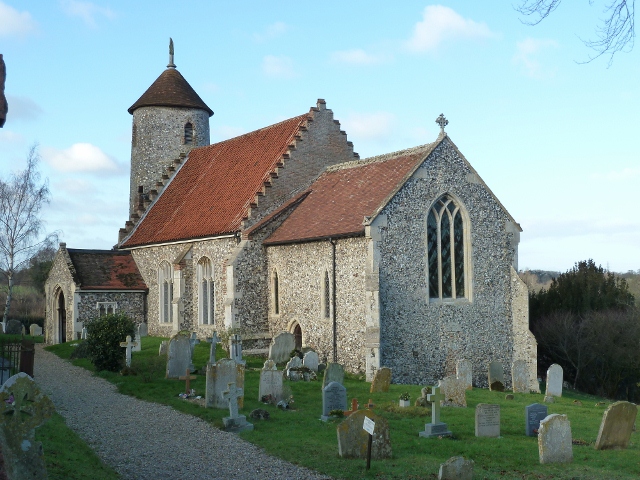
Much photographed, sketched and well documented, our charming round towered
flint church, has been a pivotal building in the village through ten centuries.
Its form was not as it is today, when it hosted the burial of Walstan in
1016, although the tower may already have been in situ. Because of his Shrine,
the church gained great wealth thanks to the hundreds of visiting pilgrims.
So much so, it was noted during medieval times that six priests were housed
in the village to deal with the numbers. These were housed in what is now
Church Farmhouse and Church Cottage. The Shrine was demolished during the
Reformation, and the church later restored by Bishop Wren in 1638. A century
ago, the church’s benefactor was Charles Noverre, who donated the bible
still in use, and the decorative rood screen. At the same time, Rev. Gabriel
Young (1892-1931) was instrumental in improving church attendance, as well
as restoring the fabric of the building (there was a grand re-opening in
1922). The pulpit came from Norwich Cathedral in 1892, and the organ (recently
restored) arrived in 1908. The tower was restored in memory of Mrs. Caroline
Young in 1905. There is a curious “poor-box” in situ, as well as 15th century
fragments of stained glass, a wall painting of similar date and ancient
poppy heads on the pews. The arms of Charles II are rare, and there are
also important brasses under the aisle matting. It is a very special place,
evidenced by its Grade One listing granted in 1983.
Back
to the Top
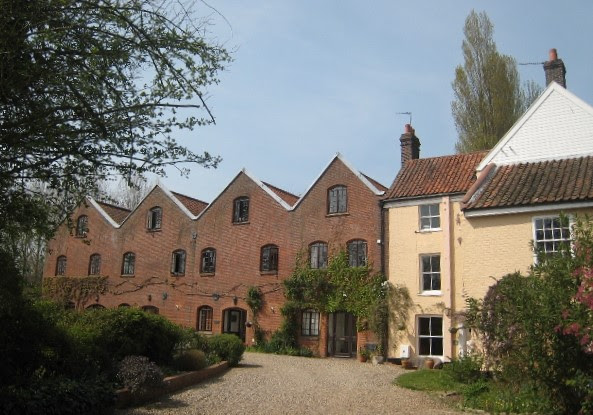
Straddling the Yare in the centre of the village, there has been a Mill in
Bawburgh since the Domesday book, although not in its present form. The present
red brick version replaced a wooden structure after a major fire in 1876, the
date brick on the front, indicates it was 1887 before completion of building.
Over the years it has had a variety of milling including cattle food and rags
for paper. There was a huge industrial chimney attached until around 1900. Jeremiah
Colman started business here in 1802, just before he started mustard milling
at Stoke Holy Cross. His peer John Wagstaffe was milling here in 1801, and left
the village his Silver Spoon legacy. It was to be another 160 years before milling
came to a close, those intervening years providing a constant hub of activity
and employment for the village. The Mill cottages were also built at the same
time to house its workers, and Childs Terrace was named by the Childs family
(millers in 1908-1929). The last Miller, Clifford Warman, hung up his floury
sacks in 1967, and one of the millstones set on the Green provides an unusual
memorial to him, as well as a reminder of the importance of the business and
iconic status of the building, The subsequent forty years have seen a succession
of private residents, with a major makeover in 1988 providing four enviable
townhouses, as well as retaining the Stable and Mill Houses. The nearby Warman
Close was so named in 2000. The Mill provides an attractive centrepiece to the
village—especially at night, when the lit windows reflect in the Mill Pool.
Back
to the Top
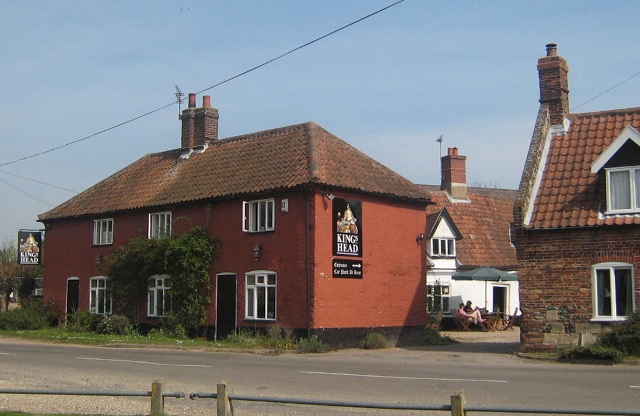
This marvellous building (rear of picture) has been a public house for more
than 200 years, when a Mr. Hart, after whom the Lane was named, let the property,
which had been built 180 years before (that is in 1602), as a pub, and named
it the Kings Head. Edward I (1272-1307), was used on the pub sign, when the
pub was a “Morgan's” pub and under tenants Billie Johnson and Billie Howlett
(from the 1930s through to the 1950s) when the cottages on the road (left) were
lived in separately. Morgan's Brewery was subsequently taken over by Watney
Mann, and the big conglomerate closed the only remaining hostelry in Bawburgh
in 1975—much to the consternation of the village. Sadly, the property was boarded
up, having been a vibrant part of the village, since 1784. It had survived alongside,
but not without rivalry, its neighbour The Cock, which closed in 1962. However,
new life was breathed into the building, when late in 1976, the Kings Head Sporting
Club was born, and with it a new Kings Head—the same Edward VII Anton Wimmer
has chosen as a suitable icon for today’s pleasures—the King being known as
a “sportsman and bon viveur”. Throughout the twentieth century, the Kings Head,
Bawburgh, was a lively and successful venue. The advent of Squash, brought Bawburgh
up to date, when John Abbot and Barry Mathews bought the shell of the 350 year
old property in 1975 and built the squash courts (not without vocal fears of
the village) and renovated the tumbling down house with the curvy roof. Thanks
to them, 30 years later, it still flourishes.
Back
to the Top

Not so much an iconic building, but an iconic structure, so pivotal as it
is, having joined the divisions of “north and south” Bawburgh for nearly 200
years, each claiming to be “upper Bawburgh”! Seriously, it is well used and
well loved. Its status as a Scheduled Ancient Monument (Number Norfolk 348)
applied in 1976 confirms its importance. It is also No. 12721 on the Sites and
Monuments Record at the Norfolk Landscape Archaeology unit, at Gressenhall Museum.
It is described as an “Arched structure of stone and brick” and although after
a visit in 1977 declared it “not worthy of comment”, when the Bridge was re-visited
in 1979, it was suitably declared “A pleasant bridge—but not outstanding”. The
County Surveyor in 1866 measured its three semi-circular arches, the centre
arch with a 16’3” span, and the outer arches of 13’8”. It is coned with 6” saddleback
Portland stone and the roadway is 13’8” wide, the parapet being 3’8” above the
road. The present bridge replaced a previous one built during the early 1600s.
It was another 200 years before the present bridge was built, in 1815, and was
the subject of work by divers late in the 1800s, when presumably the iconic
cross ties were fixed. More recent repairs took place in 2007, which hopefully
will sustain our iconic central symbol. Although a weight limit does exist,
there is no way the daily load it now endures could have been predicted when
it was built in 1815.
Back
to the Top
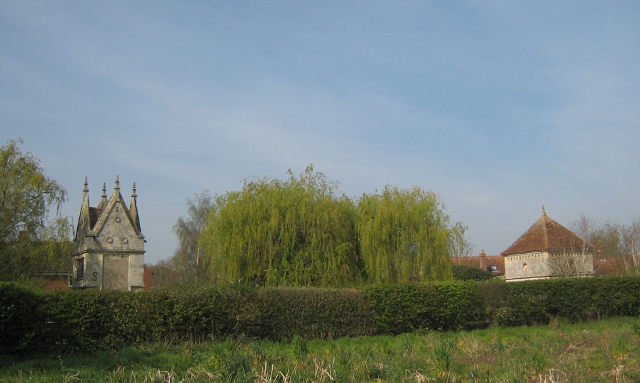
Variously described as a dovecote and slipper chapel, the two follies now
residing in the gardens of Numbers 5 and 7 Hall Farm Place, were originally
garden follies in the grounds of Bawburgh Hall. The Hall was demolished in 1963
and the follies allowed to stand, as long as the development which took place
around them in 1980, allowed for access for the public (by arrangement). These
iconic buildings have certainly been shrouded by mystery over the years, their
date much debated. The question is whether they were built at the same time
as The Hall (1634), or were later additions using old materials. The consensus
following the advice of Gressenhall records (The Slipper House is number 9301
on their Sites and Monuments Records) and expert on landscape history, Tom Williamson
of the UEA, is that they are late 16th or early 17th century garden buildings
built of stone looted from some medieval structure—the dissolved chapel of Saint
Walstan “perhaps”. Having established date, the naming continues to confuse.
South Norfolk’s List of Buildings of Special Architectural or Historical Interest
declares that the Garden House is at number 5 and was formerly a dovecote (actually
the Hermits House is at number 5) and the Slipper Chapel, now Garden House is
at number 7. We can safely assume the numbers have been switched, and that the
Dovecote is now the Garden House, since archive photos show the dove openings
where there are now windows. Mysterious and confusing perhaps, but iconic definitely!!
Back
to the Top
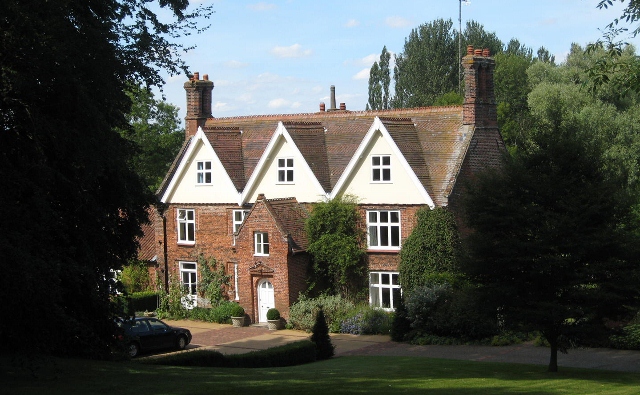
Sitting on low lying land to the north of the Church and with the auspicious
neighbour of Saint Walstan’s Well, Church Farmhouse is certainly visually a
magnificent house, with an equally fascinating history. Not so obviously, it
has not housed the Vicar of the day, since medieval times, when it was necessary
for six Priests to be accommodated there to deal with the hundreds of pilgrims
to the Well. Since then, it has simply been Church Farm. There are records of
a house on the spot since 1278 and the present 2-foot thick back wall dated
as 13th century ties in well with this. Church Cottage housed Vicars until around
1813, when Rectory House on Watton Road, and then the new Vicarage in Little
Melton were used. In the meantime the tenants of Church Farm have been closely
associated with the Church. Church Farm was not transferred from ownership of
the Church until 1820, when the Unthank family, and then Intwood Estates took
over. The Unthank family, of Intwood Hall, never lived in the house, but instead
a succession of tenant farmers, until in 1979, when the Hannison family took
over ownership. There have been two more changes,
the Green family and more recently in 2017 the Blakes.
Thankfully all families have taken their responsibilities of ownership
and restoration very seriously. The property is a Grade II* (with star) Listed
Building and continues its association with Church and Well, with the continuation
of Saint Walstan’s Day celebrations at the Well, situated in the garden.
Above information thanks to the Greens and Geoffrey Kelly’s research of 1988.
Back
to the Top
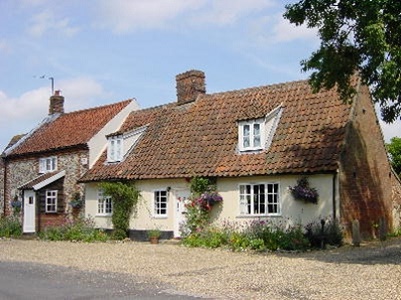
The charm of the “Old Post Office” is always visible from its central position
and a reminder of the architectural quaintness of Bawburgh. Similarities with
the Kings Head and Blacksmiths Cottage dates it around 1600. During the 20th
century, however, we know it was home to three families, with Ben and Daisy
Harmer running “Bridge Stores” from the right hand portion. In 1937, the post
office operation was transferred from Church Stores to Bridge Stores. This must
have been a major coup! Ben Harmer was called up for War Service and Daisy was
helped by Ben’s sister Elsie to “man” the shop. The property was often teeming
with evacuees during the War—handy assistants no doubt. It was a typical grocery
store of the day, with food stuffs sold separately and packed in greaseproof
paper, the sugar bagged and the bacon cut by hand. Newspaper deliveries were
carried out too. In 1919 the cottages were sold by the Costessey Estate
to the Barclays at Colney Hall, and the Harmers gradually bought the
whole from them. They stayed until 1970. After that period of stability, the
Post Office was then to have a succession of another four owners during the
ensuing twenty years. When the Williams moved to Norwich in 1993, the post office
had already been trading on a part time basis for three years, and the terms
offered by the Post Office made business for any prospective owners unviable.
Back
to the Top
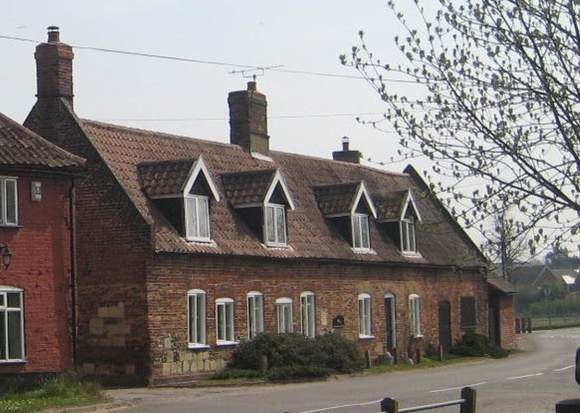
This cottage has certainly had a pole position in the village for centuries.
Always handy for the public house, it seems to have survived remarkably for
400 years right on the roadside. It has a wonderful mixture of flint, red brink
and ashlar stone construction. This type of stone can be seen in many cottages
in this central part of the village. It is not only an iconic building, but
in an iconic position, overlooking as it does, the village green and most activity
which goes on! It probably started life as a single dwelling, converted to three
cottages during the 1700s, and back again in the Twentieth Century. There are
the initials I.B. on the east gable tie ends. Old directories can direct us
to the names of Blacksmiths over the centuries, the first named, a John Brown
in 1836. His son, Daniel, had taken over by 1854. By 1868, James Cole was named
as Smith and Wheelwright. With the Kings Head next door, similar names crop
up linking the two properties. By 1883, George Chenery was Blacksmith. His son
Charlie was later to take over and he and his wife Jessie were also Landlords
next door at the Kings Head until 1928. Philip Eagle moved in in 1970 and has
sympathetically restored the property, but now, in his capacity as a sheep farmer,
the noises of bleating orphan lambs are much more likely to be heard from the
garden, than the ring of the blacksmith’s hammer on horseshoes!
Back
to the Top
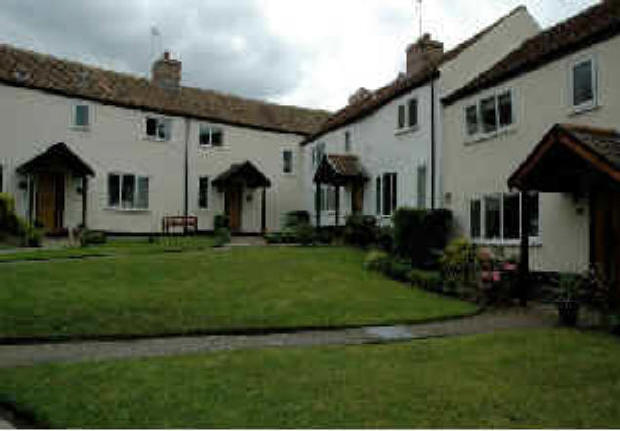
This attractive set of cottages, is symbolic of changes through
difficult and better times for the village. Built during the 17th century (although
with an even older retaining wall going back to medieval times), the terrace
was known as the Poor Yard, even in living memory. It was during the Sixties
that demolition was ordered, but they did not account for the determination
of the last tenant—Mrs. Mabel Holmes. Fortunately by the time she did eventually
move to Hockering Lane, the village was by then subject to the Conservation
Report of 1973, which promised to preserve the character and seek to improve
the village by encouraging schemes to restore decaying buildings. This was timely,
in that not only was Childs Terrace ready for demolition, the Kings Head and
Blacksmiths Cottage were in need of care and attention too. Early during the
twentieth century the Terrace was home to eight families, the Woods had to occupy
two of them (although inconveniently not adjoining!). Mostly employment would
have been at the nearby Mill, and the cottages owned by it—thus the name of
Childs, Millers during that time. With the restoration work during the Seventies,
the nine cottages became five, and something not needed before—a garage block
for five cars too. The work was carried out by Carters, and restoration completed
in 1977. With the arrival of the Goodmans at numbers one and two in 2006, the
frontage and gardens have excellent new caretakers! All this thanks to Mrs.
Holmes.
Back
to the Top
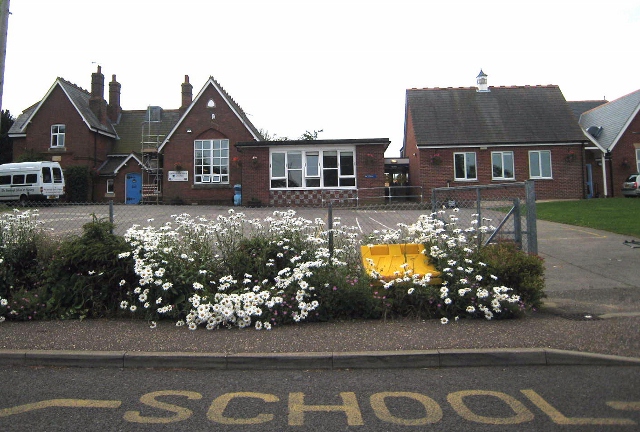
Mammoth changes have been made to this icon, over the past 132 years, that
we wonder just what Miss Ann Carter the first Headmistress would think! She
had few luxuries to aid the education of her original 54 pupils and indeed little
help by way of other teachers. There was no heating, light or indoor toilets.
Central heating did not arrive until the Sixties and indoor toilets as recently
as 1994. Now the building of 2008 is unrecognisable. The original building still
used, but two modern extensions, the last one only in 2006; the new hall adding
to the status of The Bawburgh School, which it is now known as. It has been
a stable icon through those 132 years—non more so than when the Jacksons (1892-1925)
not only lived in the Schoolhouse, but were recognised as improving conditions
and the education of their charges, which had grown in number to 77, although
attendance/truancy was a continuing problem. There was a fence to enable the
schoolhouse privacy, and there was an extension built during the “Harvest Holidays”
of 1905—just after Norfolk County Council had become responsible for its upkeep.
Pupil numbers remained about the same during this time, reaching 88 in 1919,
but as time went on it needed 19 evacuees to boost numbers in 1939 and 8 travellers
in 1978 to boost the roll. Then, by the time Mrs. Baldwin arrived twenty years
ago in September 1987, pupil numbers had dropped to an all time low of 36……
With a present pupil tally of 100, the rest, as they say, Is History!!
Back
to the Top
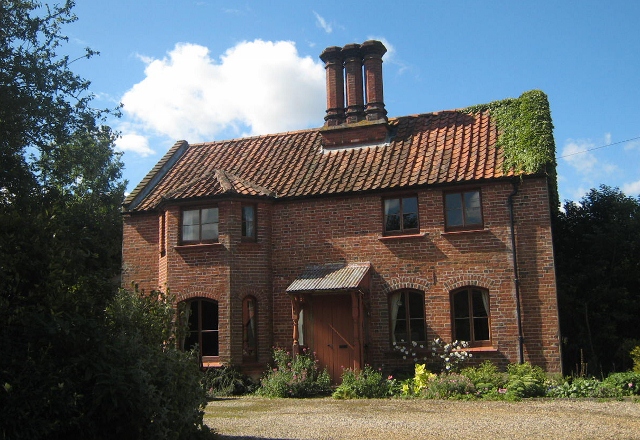
Attractively perched on the corner of Stocks Hill and Church Street, Hillside
stands sentinel to the village on its southern approach overlooking the symbolic
green triangle with the village sign. The distinguished property, with an interesting
history started life as two cottages, evidenced by maps of the early 1800s.
A photograph exists of Hillside, dated 1880 when it had become one property,
with the bay windows added, and owned by Lucy Candler, great-granddaughter of
John Wagstaffe of Bawburgh Mill. After that date, the central front door and
porch were added, and it became the country home of Charles Noverre, the grandson
of a founding Director of Norwich Union, and the great-nephew of the Chevalier
Noverre, dance master to Queen Antoinette. Thus the surname with French origins,
which also lent itself to a cinema in Norwich, became inextricably linked to
Bawburgh. Charles Noverre did not spend much of his time at Hillside, since
his home was in London, but he was a generous benefactor of the Church, and
famously hosted a charabanc trip from the Norwich office to Bawburgh in 1903.
Mrs. Laura Noverre used their country home after Charles Noverre’s death in
1920, and until her death in 1928. A Lady Robinson then owned the property until
it became the home of Herbert Baldwin, Parish Council Chairman, who held Home
Guard Meetings there during the Second World War. When it became the property
of the Websdales, Coal Merchants from Norwich, it became the subject of an article
in Homes and Gardens in which it was described as one of the most beautiful
homes in the area. It is co-incidental that the current owner of Hillside, has
just completed 11 years service as Chairman of the Parish Council, and Hillside
again matches that description. Tom and Jan Hubbard bought Hillside in 1989
and painstakingly restored it, uncovering the iconic red brick façade, and bringing
back the fine interiors and gardens.
Back
to the Top
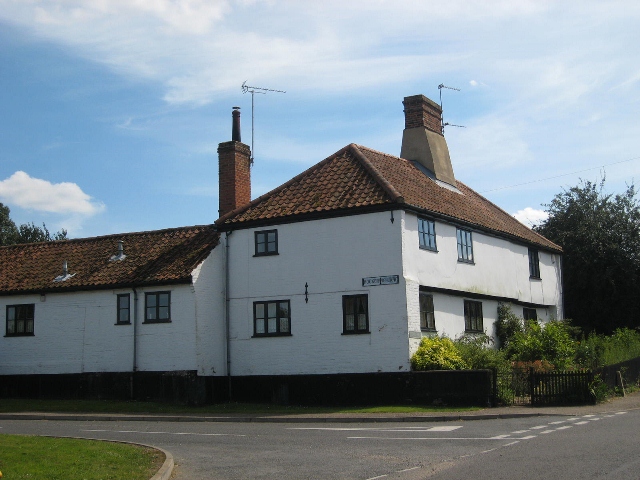
Now known as Corner Cottage (the door is actually on Hockering Lane) the landmark
building on the corner of Stocks Hill and Hockering Lane, together with its
neighbour Smugglers Cottage, was originally one. Originally dated 17th century,
some remaining interior points of interest earned its Listed status, when the
village became “conserved” in 1973. During the early part of the 20th century,
however, the property was better known as Porretts, the butchers. But this was
not a marbled refrigerated butchers shop, it had scolding baths for pigs, a
back door instead of a counter, and the cellar under the front garden acted
as the fridge! Horse and cart deliveries from Porretts were renowned and essential
for the surrounding villages. When finally the two butchers of Bawburgh, became
one, Reynolds Dobson, became Reynolds Porrett’s successor in Harts Lane, around
1921. Mrs. Porrett continued to live in the premises until the Floods arrived
in 1956. The slaughterhouse facilities had to be removed to install a “modern”
kitchen. The curiously named Smugglers Cottage then became separate and has
changed hands more times, and often used as a quaint and desirable rented holiday
cottage. Over the recent decades, Corner Cottage has been through excellent
refurbishment, and this attractive and historic building continues to be maintained
to a high standard.
Back
to the Top











